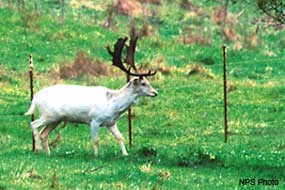
Zoo Animals in the WildernessOf the three species of wild ungulates seen at Point Reyes National Seashore, only two are native to the California coastal ecosystem, tule elk and black-tailed deer. The other species, fallow deer, was purchased from the San Francisco Zoo in the 1940s and released by a local landowner prior to the establishment of the Seashore. One other species-axis deer, which is native to India and Sri Lanka-was also introduced to the area but is no longer present. Fallow deer, natives of the Mediterranean and Asia Minor, are the most widely introduced deer species throughout the world. Descendants of these released animals, upwards of seventy animals, can be seen in the pastoral lands and the wilderness areas of the park. Hidden ImpactsFallow deer are extremely disruptive to the natural ecosystem at the Seashore. Some of the more serious effects these non-native deer have include competition for the same food and displacement of the native tule elk and black-tailed deer. Biologists believe that until their numbers decreased, beginning in 2007, the presence of this invasive species greatly suppressed native black-tailed deer, a keystone species at Point Reyes. Fallow and axis deer also have potential for transmitting paratuberculosis (Johne's disease) and exotic lice to the native ungulates. Non-native deer damage riparian and woodland habitats and have indirect impacts to the native wildlife dependent on this habitat. Loss of riparian habitat can affect a number of threatened or endangered species, such as the California red-legged frog, coho and Chinook salmon and steelhead trout. An Historic Re-IntroductionIn 1999, two dozen tule elk were re-introduced to the Limantour wilderness area of the Seashore. These animals are the founders of the first free-ranging elk population in the Point Reyes area since their local extirpation in the 1800s. Elk, historically the dominant herbivore in the coastal ecosystem, were hunted to near-extinction by early settlers to California. Because the new herd's range was used in the past decade by fallow deer, Seashore managers are concerned that competition for forage, risks of disease transmission and direct behavioral interference may all impact the long-term survival of the elk population. Expanding ThreatsIn 2002, biologists estimated there were approximately 250 axis deer and over 860 fallow deer in the park. Fallow deer, once limited to the central portion of the Seashore, could be found throughout all wilderness areas. Fallow deer range even expanded beyond the borders of the park into nearby private property and state parklands. The National Park Service and Exotic UngulatesNPS policy on non-native animals requires their control or elimination when they pose a significant threat to park values, i.e. when the species: "threaten to alter natural ecosystems; seriously restrict, prey on, or compete with native populations..." (National Park Service, 1991). A 1999 Presidential Executive Order mandated that each Federal agency: "...detect and respond rapidly to and control populations of (invasive species) in a cost-effective and environmentally sound manner..." Non-Native Deer Management PlanAfter four years of research and public participation, the NPS developed a plan to completely remove both species of non-native deer from the park by 2021. The plan responded to public comment by using both non-lethal and lethal methods to remove the two invasive species. Beginning in 2007, biologists, researchers and managers used long-acting contraception on as many non-native deer as possible and humanely removed others. The NPS donated meat and hides from culled deer to non-profit or charity organizations. By early 2009, biologists believed all axis deer had been removed from the Seashore. In the fall of 2008, the Seashore began focusing solely on contraceptive methods to control the fallow deer population. Over the subsequent few years, the park's ambitious deer contraception program involved veterinarians and wildlife contraception experts and utilized the most advanced techniques to ensure that the remaining deer herd was safely and humanely controlled. Park biologists and wildlife experts determined that application of fertility control methods had resulted in a non-reproductive remnant herd. The remaining fallow deer have not reproduced and have been allowed to live out their natural lives within the Seashore over the subsequent ten to fifteen years. The Seashore's contraception program was one of the largest studies ever attempted with free-ranging wild deer. Non-native Deer Management: Frequently Asked Questions, June 2008 You can find out more by reading the Seashore's Non-native Deer Management Plan. In May of 2008, Point Reyes National Seashore received a report prepared by the Humane Society of the U.S. (HSUS) entitled "Strategies to Manage Axis and Fallow Deer at Pt. Reyes National Seashore and Environs, Including a Proposal to Designate such Deer a Cultural and Historic Resource at PRNS." After careful review, an analysis of the HSUS report was prepared by Seashore biologists and cultural resource managers. They evaluated the report's technical soundness as well as the feasibility of the recommendations. Many of the reports proposals were discussed at length in the park's Non-Native Deer Management Plan/Environmental Impact Statement (EIS), released in 2006.
|
Last updated: September 14, 2024
